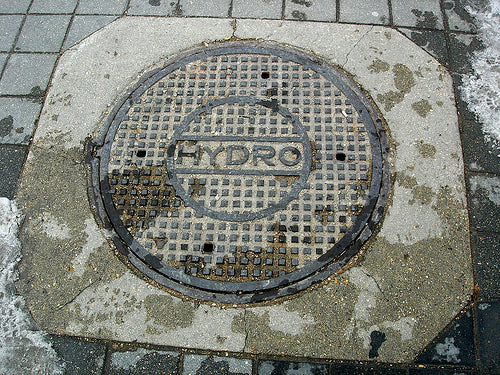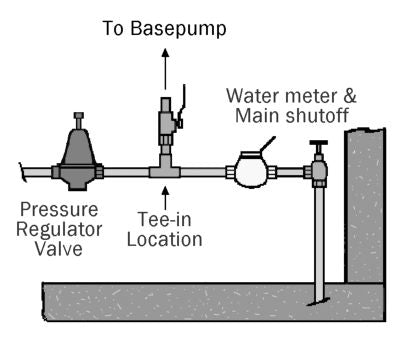
Basepump is powered by your incoming city water pressure and requires no battery or electric power to run.
Basepump is powered by a siphon ejector system, which uses city water pressure to create a vacuum source. This powerful vacuum siphons water out of your sump pit, and the city water pressure discharges it from your house.
The picture to the right shows water flowing in and out of the Basepump ejector. The Sump Water Inlet is connected to the sump pit, the Sump Water Discharge port is piped outside your home, and the City Water Inlet port is connected to your pressurized incoming municipal water supply.
A control valve governs the City Water Inlet. This remains closed until the Basepump float is activated, at which time the valve opens, allowing city water to flow into the Basepump ejector and out the Sump Water Discharge port. This flow creates the powerful suction force mentioned above, which pumps ground water out of your sump pit, through the Sump Water Inlet. The sump water is then forced out of the Sump Water Discharge port, along with the city water.
Once the float returns to its normal level, a pre-set timing control keeps Basepump pumping long enough to completely drain the sump before closing the control valve to switch off the pump.
This cycle repeats when the water level rises above normal again.
How Basepump Solves the Backflow Prevention Problem

As the only ceiling-mounted water powered sump pump system available, Basepump is actually the only pump that can include a built-in Vacuum Breaker backflow preventer to protect your clean water source.
One important consideration when choosing a water-driven backup sump pump is backflow prevention. Because these pumps use city water to create their suction power, it is imperative to ensure that this municipal water source is protected from sump pit water. Sump water must never be allowed to flow backwards into the clean city water source.
Plumbing industry professionals can tell you countless stories of homeowners who get into trouble with their town's plumbing inspectors because of insufficient backflow prevention for their water powered sump pumps. Often they are left with only two solutions: (a) buy an expensive, separate backflow prevention device that requires costly annual inspections and maintenance, or (b) remove the pump.
Basepump has solved this problem for homeowners. Several of the Basepump water-driven pumps we carry come equipped with "Vacuum Breaker" backflow preventers (RB750-AVB, HB1000-AVB, and CB1500-AVB). These devices meet industry standards (ASSE Listed, CSA Certified, IAPMO Listed), and most municipalities recognize them as effective ways to prevent backflow problems. As the only ceiling-mounted water powered sump pump system on the market, Basepump is actually the only pump that can include a built-in Vacuum Breaker backflow preventer.
Finally, it is worth nothing that, even without a backflow preventer, Basepump's design would make a backflow problem extremely unlikely in the first place - because of gravity. Its location on the ceiling, high above the sump pit, gives it the necessary height to keep sump pit water from being able to reverse direction back toward the potable water source. When it is not pumping, there is no backpressure on the Basepump Ejector. Additionally, its discharge pipe is vented to the atmosphere at a lower height than the pump itself. Gravity ensures that both the discharge and sump suction pipes are empty of sump pit water unless the pump is operating - meaning that if a backflow condition occurred, it would almost certainly just suck in air.
Water Supply Checklist

To make sure you can use Basepump pumps, verify the following 4 items:
1. Household Water Pressure: To use all Basepump models, you need incoming water pressure at the Basepump Ejector to be between a minimum of 40 PSI and maximum of 90 PSI. Take into account the pressure loss from your test point to the Basepump Ejector. Avoid excessive piping from the tee-in point (see diagram).
2. Pipe Types: You need full-flow copper piping or an equivalent (PVC, CPVC, PEX are all fine as long as they are approved in your area). Basepump CANNOT be used with galvanized iron pipes.
3. Pipeline Restrictions: Basepump needs to be teed-in to your water pipe before any devices that can restrict water flow (again, see diagram). Examples of such devices include: stop & waste valves, pressure regulator valves (PRV), water conditioners, water filters, etc. One exception: if your incoming municipal water pressure exceeds 90 PSI, then you should "tee-in" after the Pressure Regulator Valve (PRV) to prevent damage to the pump. Water meter must be minimum 3/4" standard.
4. Household Water Flow: To use Basepump pumps, you must be able to fill a 5 gallon bucket with water from your house's hose spigot within the following times.
| RB750, RB750-AVB, RB750-EZ | HB1000, HB1000-AVB, HB1000-PRO | CB1500, CB1500-AVB | |
|---|---|---|---|
| Fill a 5 gallon bucket in: | under 40 seconds | under 30 seconds | under 20 seconds |
Basepump Installation Video
To save you time, money, and hassle, the Basepump residential model RB750-EZ comes bundled with a Do-It-Yourself Installation Kit ($93 value), which includes all the specialty parts you need to install the pump, except for some basic tools and 2 easy-to-find lengths of pipe. We also sell a more basic installation kit that you can use to install the rest of the Basepump models.
The video below shows the basic Basepump installation process. Note: The model being installed in this video does NOT have a Vacuum Breaker backflow preventer. Although the installation is very similar for the models with vacuum breakers (RB750-AVB, HB1000-AVB, and CB1500-AVB), these models must be discharged independently outdoors so that water does not spill out of the vacuum breaker.
Frequently Asked Questions

Can a water powered sump pump be used with a well water source?
No, unfortunately a power outage would disable the well pump, so a well cannot serve as the water supply for a water powered sump pump. Use a battery backup sump pump instead.
Why can't Basepump be used with galvanized pipes?
Galvanized iron pipes have a smaller inside diameter than modern pipe types like copper, CPVC, or PEX. Rust and debris can easily build up in galvanized pipes, reducing water flow and potentially preventing the pump from working properly.
Where can I learn more about backflow?
Read our article on water-powered sump pump backflow prevention to learn how backflow is caused.
The word "lift" is used a lot in conjunction with sump pumps, what does it mean?
"Lift" is the height that sump water must be pumped before leaving the house. A typical basement is 7 feet tall, plus 2 feet into the sump pit, for a total of 9 feet of lift. Higher lift distance makes the pump work harder, thereby reducing its pumping rate.
Image Source: Dano
--------------
This article is intended for informational purposes. Before beginning any construction project at your home, please ensure that you take necessary safety precautions and consult construction professionals whenever necessary.
